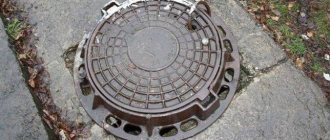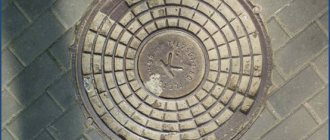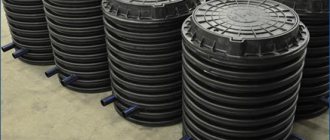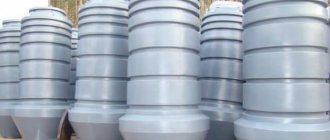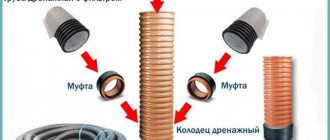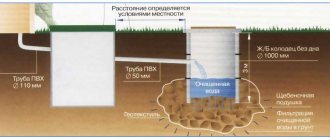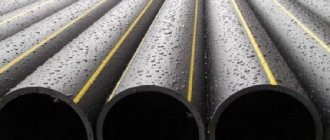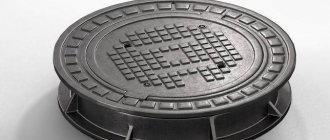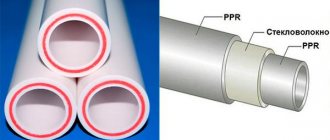Modern construction technologies when laying various types of communications require new approaches to the materials used to manufacture their elements. Heavy reinforced concrete structures of various types of wells intended for technical work on the installation and connection of sections of pipelines, inspection, storage of equipment and components are increasingly being replaced by products made of polymer materials.
Rice. 1 How are polymer manhole covers used?
It is clear that lightweight underground chambers must be equipped with appropriate products, which are plastic hatches for wells, used in various types of pipelines and free-standing closed structures. Modern hatches made of high-strength polymers are everywhere replacing traditional cast-iron products with a massive lid, popularly nicknamed “kopeyka”; they are increasingly being installed along the routes of pedestrians and vehicles with a high load on the road surface.
Scope of application of sewer manholes
Inspection wells for sewerage
A manhole cover performs a dual function - it protects people from falling into underground sewer labyrinths, and also prevents the mine from clogging with debris and foreign objects.
The products are used wherever it is necessary to close access to inspection wells:
- storm drainage;
- domestic wastewater;
- electrical cable;
- phone line;
- gas pipes;
- heating main;
- water pipes.
Depending on the expected load, the material and opening method are selected. In private areas, locks that are easier to use are installed, since the likelihood that the device will be removed is low. On your own site, you can install a less durable sewer manhole structure, since the potential load on it will be small.
The roadway requires durable products, for example, made of cast iron, which can withstand the constant load of passing cars.
How to make it yourself
The decision to make a reinforced concrete cover yourself, for example, for a sewer septic tank, is often driven by the desire to save money. The amount saved includes not only the price of the product itself, but also the cost of the forklift service. A homemade cover will not have the same high strength as a factory one, but in some situations, for home wells, this is acceptable.
Let's look at an example of how to make a reinforced concrete well cover yourself.
Necessary materials
To make a blind reinforced concrete cover you will need:
- concrete grade M200 (B15);
- reinforcement bars;
- boards for formwork;
- polyethylene film.
- In an open area, you need to dig a trench approximately 10 centimeters deep. The diameter of the trench must match the diameter of the upper ring of the well.
- Formwork is installed in the trench. Its boundaries must coincide with the boundaries of the trench.
- The bottom and walls of the formwork structure are covered with polyethylene film.
- Pour the first layer of concrete about 5 centimeters thick.
- The reinforcement is being laid.
- A second layer of concrete about 5 centimeters thick is poured.
- The concrete product is thoroughly dried. Depending on the weather, after a few hours it can be moved indoors for faster drying.
To make a cover with a hole, it is necessary, in addition to the external formwork, to install an internal formwork of the required dimensions, round or square, in the center of the trench.
A reinforced concrete cover is an important structural element of any type of well. Simple in shape and easy to install, it perfectly performs its protective functions and serves for many decades.
Construction of wells
A sewer hatch is a product consisting of a body and a cover. Both are made of the same material.
They produce locking and non-locking structures. The first ones are installed where there is access to various expensive equipment inside the mine and there is a high probability of intentional damage or theft.
The shape of the wells can be round, rectangular or square. In most cases, round sewer manholes are used, as they are the most practical and economical.
There is a hole in the lid. It is used for opening with special hooks or for monitoring, for example, gas leaks in a gas pipeline.
The lid itself is made slightly convex so that water does not accumulate in it and does not freeze in winter. The relief is necessary so that car wheels or passers-by do not slip on the metal.
There is a special marking to determine the communications to which it leads:
- TS - heating main;
- T - telephone cable, varieties - GTS and MTS;
- MG - main gas pipeline pipes;
- GS - gas network;
- PG or G - fire hydrant;
- K - domestic wastewater (sewerage);
- B - water supply;
- D - drainage or rainwater drainage.
Hatches are marked on top with letters or drawings. For example, access to an electrical cable may be indicated by a lightning bolt.
Forms
Manhole hatches can take various forms:
- Square.
- Round.
- Rectangular.
The most common ones are round. The reason is that a large number of mines have this shape. The diameter of the hatch is selected individually, although there are standards. As a rule, the guideline is based on GOST 3634 99. This standard provides for a standard diameter, as well as weight and other characteristics.
The shape of a square and a rectangle is a rare occurrence. Although the specified GOSTs mention a hatch of this shape. It can be used when arranging a personal garden. This shape may be the most convenient for lowering into a well shaft. If a rectangular product is used, one of the sides may have a minimum edge of 300 mm and a maximum width of 800 mm.
Manhole sizes and cover diameters
Sewer hatches are distinguished by load class:
- Light, small-sized hatches are suitable for pedestrian areas of private territory. Marking according to EN-124 - LM (A15). Load of at least 15 kilonewtons (1 ton = 10 kilonewtons). Product weight 45 kg.
- Light but more massive products weighing up to 60 kg are installed in pedestrian areas of public places. The rated load is also 15 kN. Marking - A15 L.
- The average hatch has a safety factor of up to 125 kN and weighs 95 kg. Recommended for parking lots, sidewalks, park areas. Marking C (B125).
- Heavy sewer manholes are used on routes with heavy traffic flow. The hatch weight is 120 kg, and the rated load is 250 kN. Designation - T (C250).
- Heavy main hatches can withstand a load of 400 kN and weigh 140 kg. They are used on intercity highways, where, in addition to passenger cars, trucks and buses operate. TM marking (D400).
- Extra-heavy sewer hatches are used in the construction of airfields and docks, where the weight of vehicles exceeds 100 - 200 tons. Loads over 600 kN with a product weight of 155 kg. Marking - ST (E600).
In the designs of heavy and super-heavy products, elements that cause load concentration at one point and provoke metal fracture are excluded. Such hatches are made on machines with numerical software, which ensures a tight fit of the cover to the body, eliminating uneven loads during impact.
The larger the size of the body and covers, the more load the product can withstand.
| Name | Housing - dimensions in mm (manhole diameter/height) | Cover - dimensions in mm (diameter/height) |
| Lightweight, compact, less than 1 t | 720/60 | 600/25 |
| Lightweight less than 2 tons | 750/90 | 690/55 |
| Lightweight less than 5 tons | 750/90 | 690/55 |
| Average less than 5 tons | 750/100 | 690/50 |
| Heavy less than 25 t | 800/110 | 700/70 |
| Square less than 2 t | 640/640 | 600/600 |
These dimensions refer to standard cast iron structures. Although the industry produces hatches of different sizes. You can find a very small one - with a diameter of 38 cm - cast iron, and a polymer one measuring 1 m.
Where is it used?
The concrete cover is used in the construction of new and reconstruction of old objects:
- main water pipelines;
- heating networks;
- gas pipelines;
- electrical and communication cables;
- stormwater, sewage and industrial sewerage systems;
- ventilation shafts;
- treatment stations.
It is important that the installed shaft is tightly closed with a lid.
The covers have some differences depending on the place of installation and the functional purpose of the objects where the product is used. The slab must have a long service life, tightly close the entrance to the mine, ensure a stable temperature inside the structure, completely block the flow of ground and sedimentary water, and serve as an obstacle to the penetration of humans and animals. The weight of the concrete cover does not allow the well rings to move horizontally.
Cover locks
Manhole cover with crab lock
Locks are designed to prevent unauthorized entry into the system and theft of expensive equipment or cables, which are usually made of non-ferrous metals. Such waste is resold to scrap metal collection points.
The locks prevent the lid from shifting, which could collapse under constant load. On the freeway, this leads to an accident, as the car's wheel gets caught in the hatch and the suspension breaks.
In pedestrian areas, two covers are usually installed - a locking one and a protective one. The locking cover is located below and has a security lock, which is available in four versions:
- Spacer mechanism.
- Crab (or ray).
- The body and cover are connected using threads.
- A lock in the form of a flag between the body and the lid.
The most reliable are the spacer and crab lock mechanisms.
Varieties based on material of manufacture
Sewer hatches are made of the following materials:
- gray cast iron;
- high-strength cast iron, which in terms of rated load is 4 - 5 times higher than gray;
- polymer sand mixture;
- plastic;
- composites;
- durable rubber;
- reinforced concrete or concrete.
Each material has its own advantages and disadvantages.
Cast iron products
Cast iron well cover
Gray cast iron is an alloy of iron and carbon. It is characterized by low shrinkage, that is, it does not shrink or expand under the influence of temperatures. It is widely used in industry, since the cost of its production is relatively low, and its characteristics are not inferior to more expensive alloys and metals.
Advantages when using cast iron hatches:
- durability;
- withstand heavy loads;
- resistance to sudden temperature changes.
The disadvantage is the large weight of the products, as well as the possibility of sparks, which is unacceptable in some areas. For example, when installed on a gas main, an explosion may occur. Cast iron products are often targets of theft, so additional protection against opening locks is required.
Ductile iron is characterized by the presence of graphite in the alloy. It is used in places where there is heavy traffic and rated loads exceed 250 kN.
Plastic hatches
Polymer cover for sewer well
One of the advantages of plastic sewer manholes is their low cost, since they can be made from recycled materials. Every year the industry offers more and more durable models that are not inferior to metal ones.
Plastic can be given any color by adding pigment at the melting stage. Plastic models are especially popular in private septic tanks and storm sewers. They install polymer hatches in pedestrian areas without fear that they may be stolen - plastic is of no value to burglars.
Synthetic materials are not affected by temperatures and do not fade under the influence of ultraviolet radiation. The appearance of the site will remain for a long time. If you do not exceed the load, the plastic will last a long time.
The only drawback is that such materials are not suitable for highways with high traffic, as they quickly collapse.
Polymer sand mixture
Polymer sand floor
It is a combination of sand - 70% and plastic waste - 30%. The quality of the finished mixture depends on the purity of the raw materials - the absence of technical oils in it. After grinding and melting the components, a product of any shape can be cast from the mixture. After hardening it acquires the following characteristics:
- not exposed to aggressive liquids, therefore can be used in wells with household and industrial waste;
- resistant to low and high temperatures;
- weighs little;
- does not cause a spark, so the product is safe.
Hatches have no material value compared to cast iron or iron.
Due to the fragile component in the composition - sand - sewer manholes made of polymer-sand mixtures cannot withstand heavy loads. They are used in private septic tanks, green and pedestrian areas.
Hatches made of composite material
Composite sewer hatch
Premix composite material is popular. Production is based on the use of nanomaterials, which allow for good mixing of components in the composite.
Premix contains:
- fiberglass;
- calcite;
- polyester resins;
- other additives.
The material is obtained by heating to 100 degrees, after which products of the desired shape are cast from it. Composite hatches can withstand loads of up to 40 tons, are lightweight and have excellent durability. They are not valuable to burglars, so they last longer.
The price of a composite sewer hatch is quite high - this is the only drawback.
Rubber sewer manholes
Rubber sewer hatch
Cast iron structures can be replaced with high-strength reinforced rubber. This material does not rust or crack. Specially prepared rubber is resistant to high and low temperatures and aggressive liquids.
Rubber covers are used in various systems - fire extinguishing, water supply and drainage in the private and industrial sectors. Robbers don’t touch them, so it’s safe to place such models in public places.
For high-quality installation, it is necessary to prepare the base - fill it with concrete. The cover is mounted flush with asphalt or soil.
Concrete and reinforced concrete
Reinforced concrete slab for a well
For the manufacture of concrete and reinforced concrete hatches, high-quality cement is used - resistant to moisture and mechanical stress. Used in combination with concrete rings: after installing the top plate with a hole for the hatch. For convenience, metal handles are poured into the concrete.
Advantage:
- low cost;
- weight - it is almost impossible for children or teenagers to lift a heavy slab;
- durability.
The disadvantages lie in the appearance of the product - it will not be possible to give a certain color to concrete due to poor adhesion to dyes.
Installation
There is nothing complicated about installing a reinforced concrete well cover. The main thing is to maintain maximum precision and accuracy at every stage. If a heavy, large-sized product is being installed, it makes sense to take care of the loader in advance and think about how many people will need to be involved in the work.
First of all, it is necessary to seal each seam of the inlaid “trunk” of the mine. The cover is installed on the upper ring of the concrete well. The joints of the upper cut of the ring must be sealed hermetically. To do this, use a moisture-resistant sealant that is not susceptible to precipitation. The hole in the slab must be closed with a hatch (if this element was not originally installed by the manufacturer). Hatches differ in the material they are made of: concrete, cast iron, plastic, etc. If you plan to install a well element in a high-traffic area or on a highway, it is better to choose an option made of cast iron.
The cover is attached to the well ring using cement mortar.
ATTENTION! If a slab with seams is used during installation, a hemp rope must be laid around the perimeter.
Concrete covers for wells are necessary to securely cover the structure. These products, easy to manufacture and install, will provide long-term protection to the constructed structure.
Installation and securing
Installation of a sewer hatch
Lightweight polymer or polymer-sand hatches can be installed independently. Heavy cast iron or concrete structures will require the help of other people or equipment. On walkways, covers should be flush with the surface. If the hatch is placed in a flowerbed, it is better to raise it slightly above ground level so that dirt does not fall into the well.
DIY installation work steps:
- First, the support ring is installed on a solid base - the formwork. For accuracy, you must use a level. If the installation is carried out on a slope, the structure will eventually become unusable and collapse. A cement solution is used to connect the concrete rings to the hatch support ring. When it has completely hardened, work can continue.
- The cover is installed. How to do this depends on the model.
- The final stage is pouring the blind area. This is done at a distance of 1.5 m from the center of the hatch. A cement solution is used. To ensure that the blind area has a neat appearance, the edges are fenced off with brick or bendable metal, the bottom is covered with sand and filled with concrete. When it hardens, the devices are removed.
After installing the manhole, it can be decorated with artificial stone or covered with a layer of synthetic grass. Flowerbeds are sometimes set up in the covers so that the vegetation hides the presence of a septic tank on the site.
It must be remembered that the well may need to be serviced at any time, so the top of the cover should not be too cluttered.
Repair
The hatch must be located flush with the ground or road surface so that vehicles and pedestrians can move freely. Simple manipulations will help eliminate irregularities that may form around the well cover on the road:
- Formwork is placed around the well, retreating about 50 cm.
- The support ring is laid, checking the horizontal position using a level, and fixed with metal beacons.
- Prepare a solution that matches the characteristics of the coating surrounding the structure.
- The formwork is filled with mortar and wait until it hardens completely.
When choosing a method for arranging the entrance to a manhole, first of all, take into account the characteristics of the cover material.
Prices for various types of hatches
The cheapest products will be those that cannot be subjected to heavy loads. These are hatches made of plastic or polymer-sand mixtures. Rubber is characterized by low cost but higher performance characteristics. If we are talking about installation on a summer cottage or near a private house, then there is no need to overpay for cast iron products.
Composite materials and high-strength cast iron are more expensive. These materials are chosen if pressure will be applied to the hatch every day, for example, a sewer well is located in the area of vehicle traffic. The price of a cast iron manhole is comparable to the cost of synthetic material.
The cost of products also depends on the size - diameter and height of the lid.
